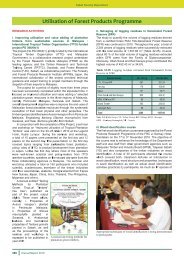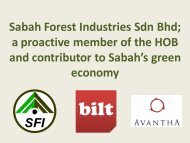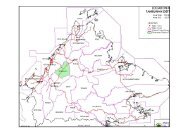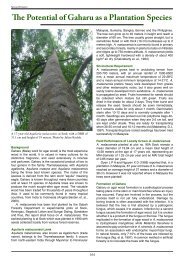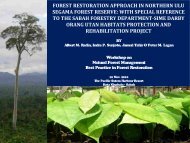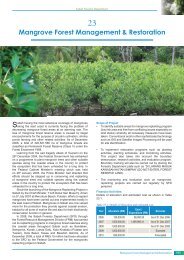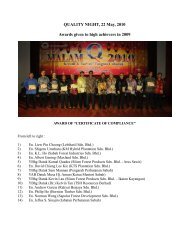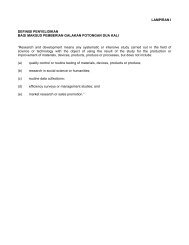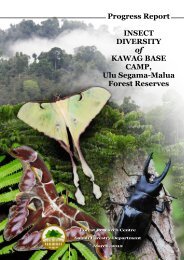Forest Management Plan - Sabah Forestry Department
Forest Management Plan - Sabah Forestry Department
Forest Management Plan - Sabah Forestry Department
Create successful ePaper yourself
Turn your PDF publications into a flip-book with our unique Google optimized e-Paper software.
4.4 High Conservation Value <strong>Forest</strong>s (HCVF)4.4.1 IntroductionIdentification of HCVF is a new and evolving discipline and therefore, there is no ‘right’way to perform an HCVF assessment. This makes identification of all potential HCVFattributes in FMU 17A challenging especially when detailed information about portions ofthe area are still lacking. Consequently, in this FMP, it only synthesizes existing data toidentify HCVFs within FMU 17A while the HCVF assessment should be considered as awork in progress, which will be refined as more information is available.Meanwhile, identification of HCFV is an important component of certification accordingto the standards of the <strong>Forest</strong> Stewardship Council (FSC). The FSC introduced theconcept of HCVFs in 1999. HCVFs possess one or more of the following attributes:• <strong>Forest</strong> areas having significant concentrations of biodiversity values (e.g. areas ofhigh endemism, areas known to support endangered species and areas rich inwildlife) – HCVF 1;• <strong>Forest</strong> areas in the form of natural forest cover where naturally occurringspecies exist in natural patterns of distribution and abundance – HCVF 2;• <strong>Forest</strong> areas that may provide representative samples of natural populations intheir undisturbed form (e.g. pristine forest) or forest areas that are in or containrare, threatened or endangered ecosystems – HCVF 3;• <strong>Forest</strong> areas that may provide basic services of nature and are sensitive todisturbance (e.g. watersheds, areas on steep slopes, areas sensitive to soilerosion) – HCVF 4;• <strong>Forest</strong> areas fundamental in meeting the basic needs of local communities (e.g.subsistence, protein, medicines, building materials, and clean water) – HCVF 5; and• <strong>Forest</strong> areas critical to local communities’ cultural integrity (e.g. areas of culturaland ecological significance) – HCVF 6.The first four attributes listed above focus on environmental HCVFs while the last two,are on social and cultural needs of the local communities.29



